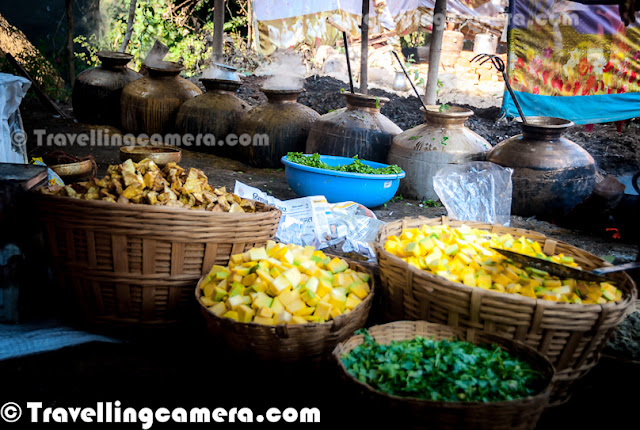Mandi Dham || A Special food preparation process during various celebrations in Mandi region of Himachal Pradesh, INDIA
Today we are sharing some of the clicks from temporary kitchen built during some special celebrations in most parts of Himachal Pradesh. This Photo Journey will take you through various preparation steps of 'Mandi Dham'. 'Dham' is lunch which is served during special occasions. Let's check out this Photo Journey to know more about it.
First photograph of this Photo Journey shows main utensils used to cook food in Himachali Marriages or other special occasions.
This is how Dham Kitchen looks like. Above photograph shows a row of containers which are used for cooking and vegetables in foreground. The preparations for Dham begin a night before when all these containers are collected from people in the village/town. This temporary kitchen is built with bamboo sticks as main pillars and steel-sheets as roof. Usually built outside the main house, but not too far. These chefs prefer it to be open unless there are rains or windy weather.
Dham
is prepared by Botis, who are Brahmin chefs in Himachal and have been in this
profession for generations. Botis can usually be seen in dhoti and bare feet. No one is allowed inside the kitchen with footwear. It's a big NO. Everytime they enter into the kitchen, they clean their hands.
Most of the utensils used for cooking food in dhams are copper or brass. Mostly every house in a village/town has such utensils and they are collected in this temporary kitchen, one day before. Above photograph shows all big containers on right which are used for cooking. One of the chefs moving around the place and busy with settling down things and the second one if having some rest. On the extreme left of the photograph, one of the villager is pouring in butter-milk into a big container. During morning, every villagers brings milk & buttermilk to this kitchen, as most of them have these things in abundance at home.
A closer look into the kitchen where chef is putting some onions into one of these copper containers.
Usually this day starts with all villagers come together and help these chefs in cutting vegetables and arranging other stuff like spices etc. It's usually a session of 2-3 hrs when everyone keep raw material in place for chefs to do their job in better way. Most of the folks are trained and can take care of this work independently. Many times, some of the vegetables are arranged within the villages, depending upon the season. Pumpkins are used is some of the dishes and mostly fresh out of village-farms. Various other fresh vegetables are used in this preparation.
These bananas are also used in preparations as times. There were times, when every villager used to be cautious about planning various marriages in village and save such stuff accordingly. Still many of these things are followed religiously.
When food is ready, it is served in courses to people who sit on floor. Leaf
plates are utilized to serve the food, although plastic plates are also
being used these days. Dishes include plain rice, Madra (Sepu
badi or Mukand badi, kidney-beans, White grams, Paneer etc), Palda (a curd based
dish or curry), jhol (curd rice), mustard based raita or pulses, pulses and sweet rice or Mithdee (made of boondi, Bread crumbs etc). Dishes vary from one region to another as per local culture. Dhule maah (dhuli Urad dal) cooked in desi ghee is a specialty of Mandi Dham while Chambayali Rajmah is the specialty of Chamba dhaam and Kaale chane ka khaata (Sweet and sour sauce) of Kangra dham.
These huge containers are known as 'Charoti' or 'Batloi', and various other names specific to regions & language.
The deep line with fire is called as 'Char' or 'Tiun' and have various other names. Wood-fire is used for cooking dham and dry wood is arranged few weeks in advance. This is another activities where almost every family in the village participate.
Mostly rice is servced in dhams and there is hardly any arrangement for bread(rotis). Above photograph shows the container made up of bamboo, which is used for serving hot rice.

.jpg)

.jpg)
.jpg)
.jpg)

.jpg)
.jpg)



.jpg)
Comments
Lovely pictures :-)
It's an awesome experience and I can better appreciate it while in delhi :)
I love धाम